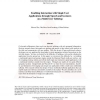Free Online Productivity Tools
i2Speak
i2Symbol
i2OCR
iTex2Img
iWeb2Print
iWeb2Shot
i2Type
iPdf2Split
iPdf2Merge
i2Bopomofo
i2Arabic
i2Style
i2Image
i2PDF
iLatex2Rtf
Sci2ools
AVI
2006
2006
Enabling interaction with single user applications through speech and gestures on a multi-user tabletop
Co-located collaborators often work over physical tabletops with rich geospatial information. Previous research shows that people use gestures and speech as they interact with artefacts on the table and communicate with one another. With the advent of large multi-touch surfaces, developers are now applying this knowledge to create appropriate technical innovations in digital table design. Yet they are limited by the difficulty of building a truly useful collaborative application from the ground up. In this paper, we circumvent this difficulty by: (a) building a multimodal speech and gesture engine around the Diamond Touch multi-user surface, and (b) wrapping existing, widely-used off-the-shelf single-user interactive spatial applications with a multimodal interface created from this engine. Through case studies of two quite different geospatial systems Google Earth and Warcraft III we show the new functionalities, feasibility and limitations of leveraging such single-user applications...
AVI 2006 | Multimodal Tabletop | Multimodal Tabletop Applications | Single-user | Software Engineering |
| Added | 30 Oct 2010 |
| Updated | 30 Oct 2010 |
| Type | Conference |
| Year | 2006 |
| Where | AVI |
| Authors | Edward Tse, Chia Shen, Saul Greenberg, Clifton Forlines |
Comments (0)

